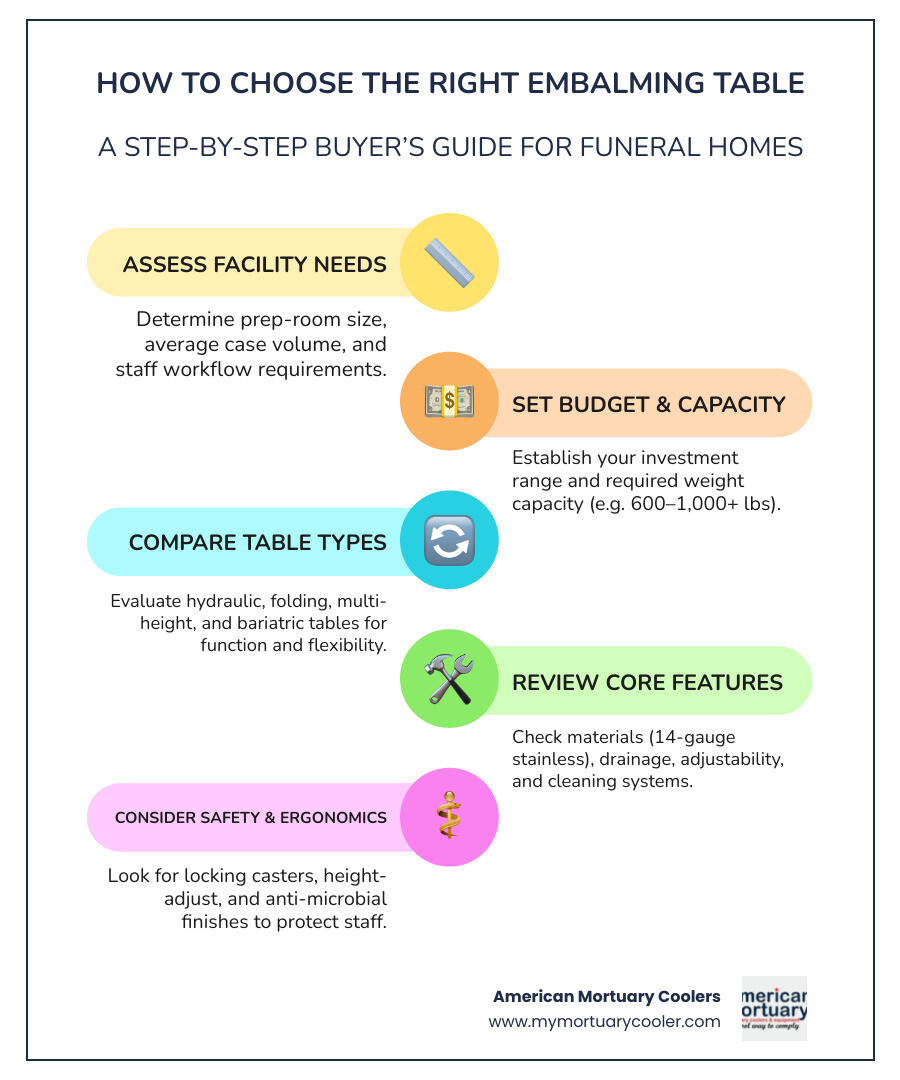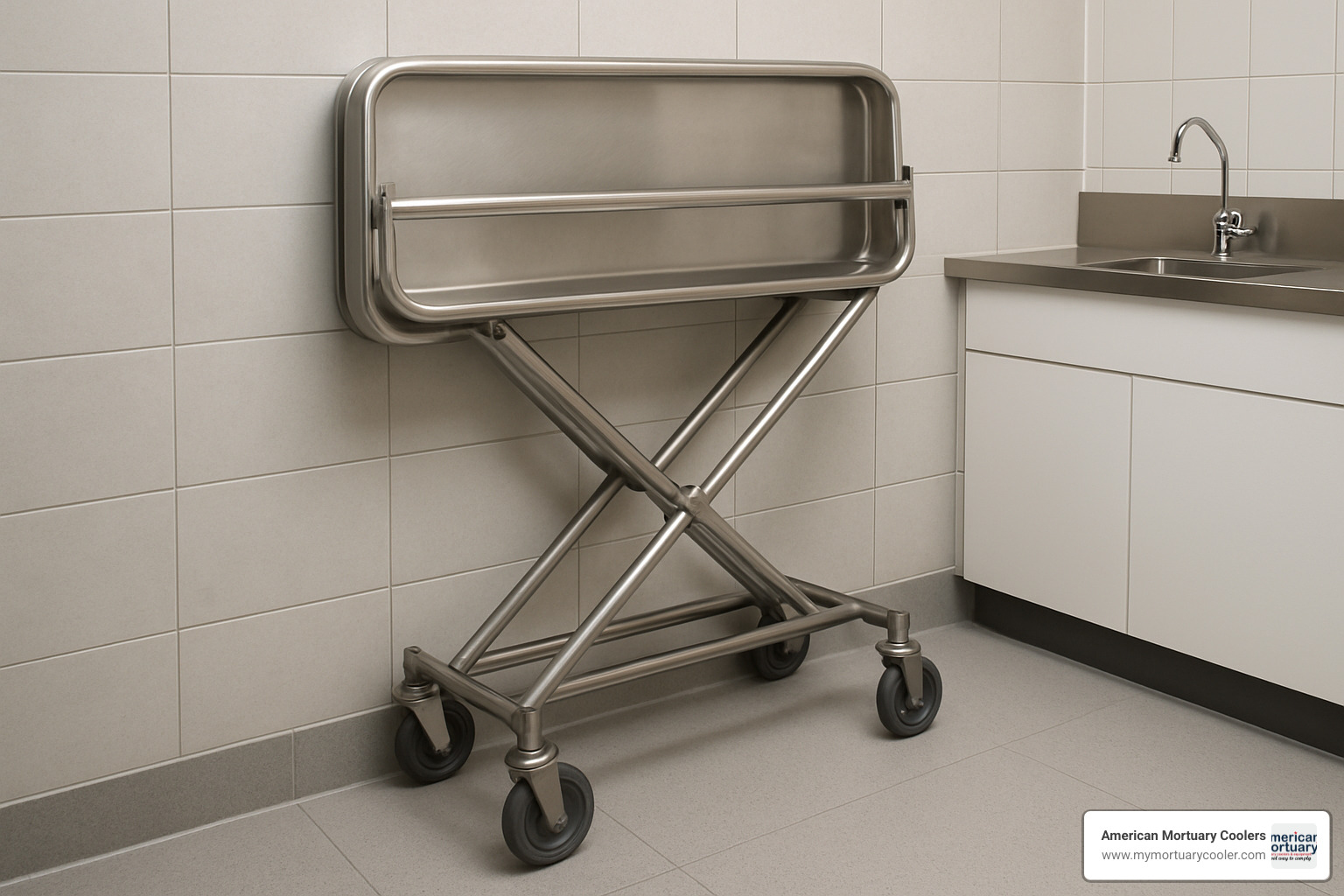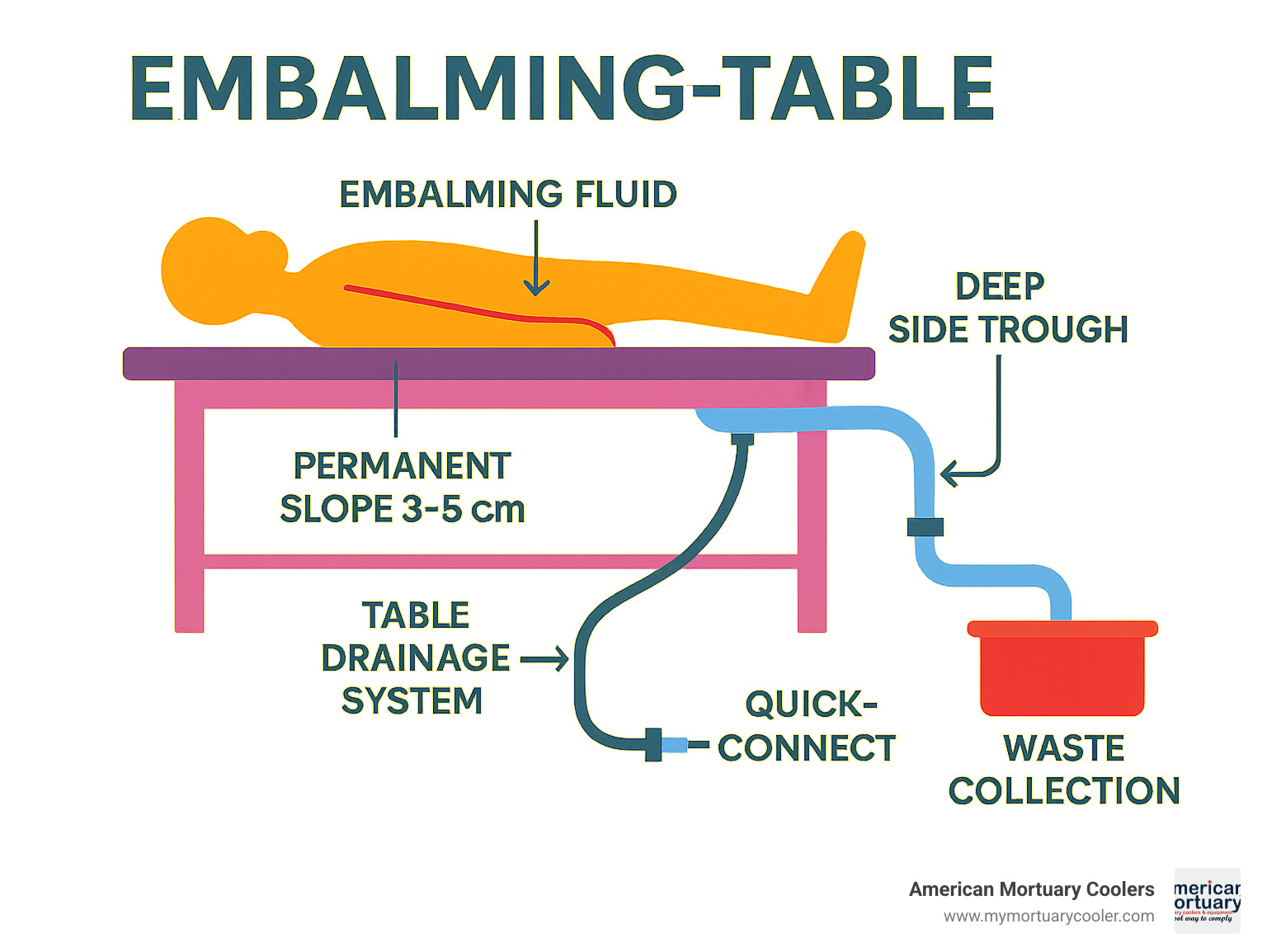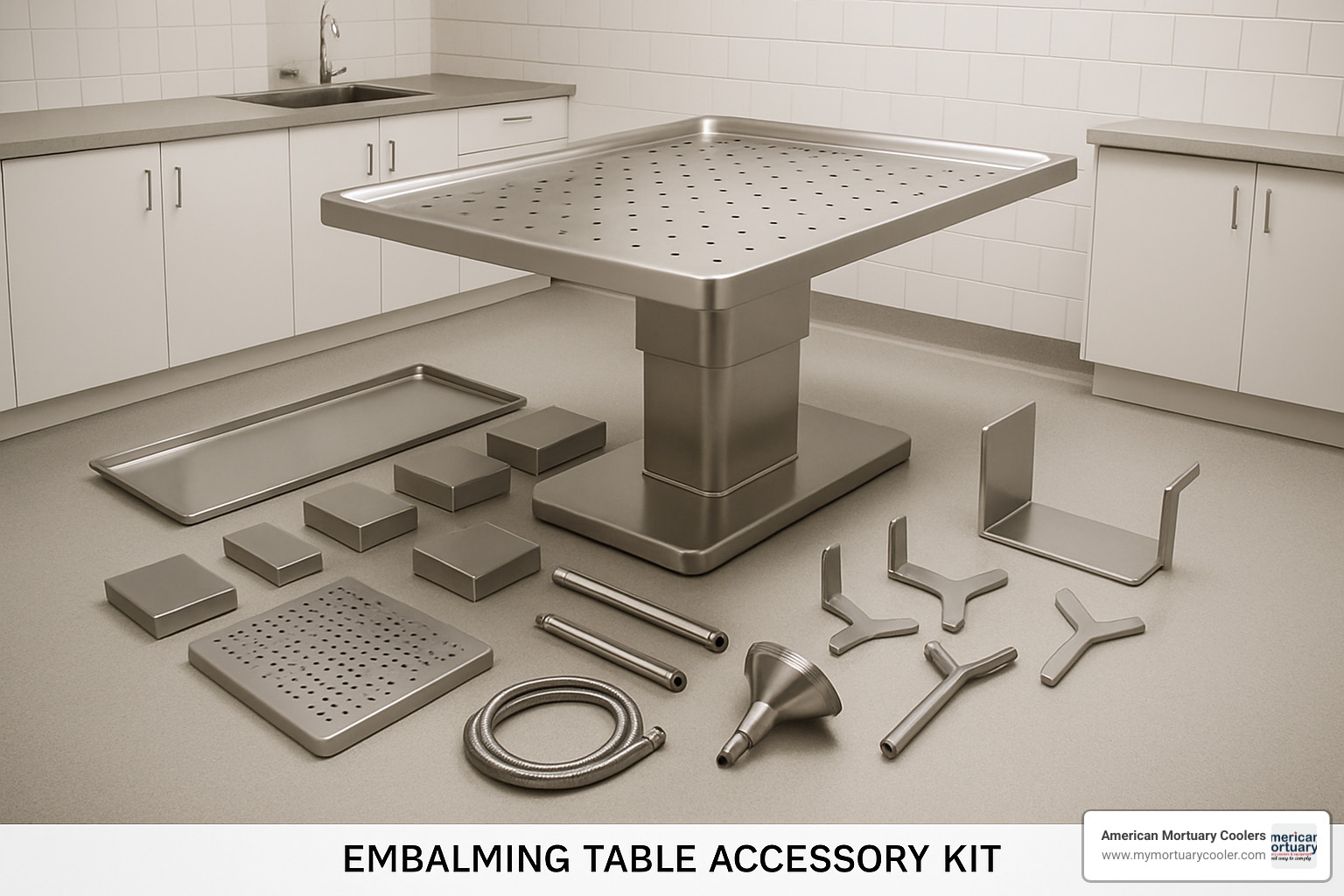Why Embalming Tables Are Critical for Every Funeral Home
An embalming-table- is the foundation of every mortuary prep room - a specialized stainless steel platform designed for the safe, sanitary, and efficient preparation of human remains. These tables feature convex surfaces with deep drainage troughs, adjustable heights, and mobility systems that support weights from 600 to over 1,000 pounds.
Key embalming table features you need to know:
- Materials: 14-gauge AISI 304 stainless steel construction
- Dimensions: Standard 32-35" wide by 80-85" long
- Weight capacity: 600-1,000+ pounds depending on model
- Height range: Adjustable from 30-38 inches
- Types: Hydraulic, folding, multi-height, and bariatric options
- Price range: $1,095 for basic folding models to $20,000+ for specialized autopsy tables
The right embalming table directly impacts your facility's workflow efficiency, staff ergonomics, and ability to provide dignified care. Modern funeral homes face increasing demands for faster turnaround times while maintaining the highest standards of care.
I'm Mortuary Cooler, a national-level mortuary cooler supplier with extensive experience helping funeral homes select the right embalming-table- solutions for their specific needs.

Embalming-table- vocabulary:
What Is an Embalming Table and Why It Matters
Think of an embalming-table- as the heart of every funeral home's preparation room. It's a carefully engineered workstation designed specifically for the respectful preparation and preservation of human remains. Every curve, drain, and feature serves a critical purpose in the embalming process.
The main job of these tables is preservation through controlled chemical application. During embalming, funeral directors inject preservative fluids through the arterial system while simultaneously draining blood and other bodily fluids. This delicate process requires precise drainage systems and contamination control.
Safety drives every single design choice you'll see on a quality embalming table. OSHA requires specific features like chemical resistance, easy sanitization, and ergonomic operation. That distinctive convex (curved) surface prevents dangerous fluid pooling and reduces splash-back during procedures.
Modern prep room standards require 14-gauge AISI 304 stainless steel construction. This specific steel grade provides exceptional resistance to harsh embalming chemicals while maintaining structural integrity under heavy loads. The smooth, non-porous surface prevents bacterial growth and makes sanitization easier.
Core Anatomy of the Table
The surface gradient is essential for proper drainage. Quality embalming tables feature a permanent 3-inch slope that naturally channels fluids toward collection points. Those deep side troughs running along the edges capture and direct drainage while preventing spillage onto your prep room floor.
The drain stem connects your table to the facility's waste management system through quick-connect fittings. Mobility matters - quality tables feature 6-8 inch swivel casters with individual brake locks that support the table's full weight capacity while providing smooth movement.
Weight capacity varies significantly depending on your needs. Basic folding models handle around 600 pounds, while specialized bariatric units can support up to 1,500 pounds. More info about x services
Main Types of Embalming Tables
Different facilities have different needs, and manufacturers have responded with several distinct table types. Hydraulic models offer smooth powered adjustments for improved ergonomics. Folding tables solve space constraints, while bariatric platforms address the need for equipment that can safely handle larger individuals.
The key is matching your table choice to your actual workflow. A busy urban funeral home needs different equipment than a small rural operation.
Hydraulic Models
Hydraulic embalming tables use foot-pedal controls that let your staff adjust working height from 30 to 38 inches without stopping their work or contaminating controls with gloved hands. When technicians can position the table at their optimal working height, you see less back strain and fewer work-related injuries.
Most hydraulic models support up to 1,000 pounds safely, with the hydraulic system distributing weight evenly regardless of height setting. Hydraulic tables cost more - typically $2,885 to $3,995 - but many facilities tell us these tables earn back their cost within the first year through improved productivity.
| Feature | Hydraulic Tables | Folding Tables |
|---|---|---|
| Height Adjustment | Powered foot-pedal control | Manual end-adjustment |
| Weight Capacity | Up to 1,000+ lbs | Typically 600 lbs |
| Price Range | $2,885-$3,995 | $1,095-$1,674 |
| Storage | Fixed installation | Compact folding |
| Ergonomics | Superior | Good |
Folding & Multi-Height Choices
Folding embalming tables collapse flat against walls or tuck into storage areas when not needed, giving you maximum flexibility. These designs are perfect for facilities that need to convert prep rooms for other uses or provide mobile services.
Multi-height folding models offer independent end adjustment that ranges from about 32.5 to 38.5 inches. This gives you drainage control by creating proper gradient while accommodating technicians of different heights.

When folded, these tables typically measure less than 6 inches thick, allowing them to slip into closets or stand against walls without dominating your space.
Bariatric & Specialty Platforms
Bariatric embalming tables stretch up to 48 inches wide and support weights of 1,500 pounds or more. These require completely reinforced frames and specialized mobility systems designed for increased load requirements.
Bariatric trolleys combine transport and preparation functions. Their low-profile design makes transfers easier while providing all necessary drainage and sanitation features. Pediatric-sized tables maintain the same construction quality while providing appropriate dimensions for infant and child preparation.
Key Features & Specifications to Compare
When shopping for an embalming-table-, materials and construction details make the difference between a table that serves you well for decades and one that becomes a constant source of frustration.
Material quality starts with 14-gauge AISI 304 stainless steel - the industry gold standard. This steel resists corrosion from harsh embalming chemicals while maintaining structural strength. The smooth, non-porous surface prevents bacterial growth and makes sanitization straightforward.
Surface design matters more than most people realize. A proper convex surface with permanent gradient automatically channels fluids toward drainage points. Modern designs increasingly include ventilation integration points that work with downdraft systems to remove chemical vapors at the source.
Drainage & Cleaning Systems
The drainage system is where many tables succeed or fail. Deep side troughs measuring 2-3 inches deep with rounded corners represent the minimum you should accept. These channels must run the full length of the table and connect to properly positioned drain stems.
Permanent slope design eliminates guesswork. Quality tables incorporate a 3-5 cm permanent gradient that automatically channels fluids toward collection points. Quick-connect rinse systems make cleaning between procedures much faster and more thorough.

Dimensions & Capacities
Standard dimensions of 32-35 inches wide by 80-85 inches long accommodate the vast majority of cases while fitting within typical prep room layouts. Height adjustment typically ranges from 30-38 inches, accommodating technicians from about 5'2" to over 6' tall.
Weight capacity specifications must account for both the deceased individual and any positioning equipment. Basic folding models support 600 pounds, while heavy-duty hydraulic units handle 1,000+ pounds. Bariatric models extend capacity to 1,500 pounds or more.
Safety & Ergonomics
Locking wheel systems provide essential stability during procedures. Quality casters include individual brake mechanisms accessible via foot pedals. Lift-assist features reduce physical strain when positioning or adjusting table height. Anti-microbial welds eliminate bacteria-harboring crevices that compromise sanitation efforts. Scientific research on ergonomic lift tables
Choosing the Right embalming-table- for Your Facility
Finding the perfect embalming-table- becomes clearer when you break it down into practical considerations. Your budget sets the foundation, but don't just look at sticker price. That basic folding model at $1,095 might seem like a bargain, but if your technicians struggle with back pain or spend extra time on cleanup, you're paying hidden costs daily.
Think about your workflow honestly. How many cases do you handle weekly? High-volume operations benefit from hydraulic models that save time, while smaller facilities might prefer space-saving folding tables. Your staff deserves consideration too - if you have technicians of different heights, height adjustment becomes essential.
Space constraints often make the decision for you. Measure your prep room carefully, including door widths and turning spaces. Don't forget local regulations - your health department might have specific requirements for drainage systems or material certifications.
The Essential Guide to Choosing the Right Embalming Table for Your Mortuary
Price Ranges & Financing
Basic folding models start around $1,095 - perfect for facilities with limited budgets. Hydraulic tables range from $2,885 to $3,995, where powered height adjustment saves technicians' backs and speeds procedures. Specialized autopsy tables cost $10,000 to $20,000 but include integrated scales and advanced ventilation.
Warranty coverage varies, so pay attention. Quality manufacturers typically offer 2-3 years on structural components. Leasing options help when cash flow is tight, with many suppliers offering lease-to-own programs.
Accessories & Add-Ons for Your embalming-table-
The right accessories transform a good embalming-table- into a great one. Body blocks and positioning aids make procedures smoother. Leg braces and extension panels solve cases that don't fit standard dimensions.

Advanced drainage systems upgrade basic table connections for facilities needing holding tanks or filtration stages. Foot pedal systems keep hands free and reduce contamination risk, managing drainage valves, rinse cycles, and ventilation.
At American Mortuary Coolers, we help facilities nationwide choose the right combination of table and accessories with direct delivery across all 48 contiguous states.
Maintenance & Sanitizing Best Practices
Taking care of your embalming-table- maintains a safe, sanitary workspace that protects both your staff and the families you serve. Your daily routine should start with thorough wipe-down using neutral-pH cleaners specifically designed for stainless steel.
Stainless steel polish creates a protective barrier that makes future cleaning easier and helps prevent corrosion. Don't forget those caster wheels - weekly inspection prevents costly repairs. Annual gasket checks are your best defense against hydraulic leaks and system failures.
Regulatory compliance requires documented maintenance procedures. Keep detailed logs of cleaning and maintenance activities - they're proof of your professional standards. The Complete Guide to the Embalming Process
Step-by-Step Cleaning Protocol
Pre-rinse with lukewarm water to remove visible contamination before applying chemicals. Disinfection requires EPA-approved chemicals formulated for mortuary use. Rinse down thoroughly to remove all disinfectant residues. Drying prevents water spots and eliminates moisture that bacteria need.
Log sheet completion documents your work and provides compliance records health inspectors expect to see.
Long-Term Care & Repairs
Hydraulic system maintenance involves periodic fluid changes and component inspections. Seal replacement becomes necessary as exposure to chemicals breaks down materials. Caster rebuilding extends mobility system life, while surface regraining can restore your table's finish if it becomes damaged over time.
Real-World vs Fictional Tables in Popular Culture
If you've ever played Graveyard Keeper, you might think building an embalming-table- involves nailing wooden planks together. The game treats embalming tables like magical furniture that stops decay timers - which couldn't be further from reality.
In the game, players craft tables using basic hardware store materials. The contrast with real mortuary equipment is striking. That wooden table would collapse under a 600-pound load and couldn't handle corrosive embalming chemicals.
Real embalming-table- specifications involve 14-gauge stainless steel construction, sophisticated drainage systems, and hydraulic mechanisms - not something you craft with experience points. Embalming table in Graveyard Keeper
Lessons from Fictional Settings
Despite differences, fictional portrayals teach us about mortuary science. The game's stacking effects mirror how real embalming combines multiple treatments. These fictional settings spark curiosity that bridges entertainment and education, creating opportunities for funeral professionals to educate communities about the dignity and complexity of real death care practices.
Frequently Asked Questions about Embalming Tables
What makes stainless steel the industry standard?
14-gauge AISI 304 stainless steel offers exceptional corrosion resistance against harsh embalming chemicals. The non-porous surface prevents bacterial growth and makes sanitization straightforward. Smooth surface finish with properly matched welds eliminates hard-to-clean crevices where contaminants hide.
How does a hydraulic embalming table improve ergonomics?
Hydraulic tables provide precise height adjustment from 30-38 inches using foot-pedal controls. This means technicians of different heights can find their perfect working position without compromising posture. Hands-free operation lets you adjust height mid-procedure without breaking sterile technique.
Can one table serve both embalming and autopsy needs?
Combination tables can handle both functions if your facility performs both procedures. However, dedicated autopsy tables offer specialized features like integrated scales and specimen collection systems. High-volume facilities often benefit from separate equipment optimized for each function, while smaller operations find quality combination tables serve both purposes adequately.
Conclusion
Finding the perfect embalming-table- affects every aspect of your daily operations. Whether you choose a budget-friendly $1,095 folding model or need the advanced ergonomics of a $4,000 hydraulic system, your decision shapes staff comfort and the dignity of care you provide.
A hydraulic table might cost more, but consider what you're buying: reduced back strain, fewer sick days, better job satisfaction, improved drainage systems, and height adjustability that accommodates your entire staff.
At American Mortuary Coolers, we've watched funeral homes transform their operations with the right equipment choices. Our custom fabrication approach means you get exactly what your facility needs. Tennessee craftsmanship meets nationwide service in everything we build, supporting professionals from coast to coast.
The funeral industry demands equipment that works flawlessly when families are counting on you. You can't afford downtime. That's why our focus on robust construction and thoughtful design pays dividends long after installation.
Ready to upgrade your prep room foundation? Let's talk about your specific needs and explore how our custom solutions can improve your facility's capabilities. The Ultimate Guide to Finding the Best Embalming Tables


















